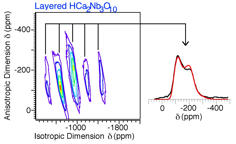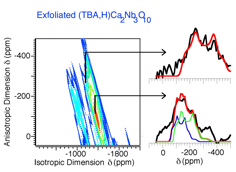Reports: AC5
46923-AC5 Determining the Effect of Local Structure on Acidity in High Surface Area Oxides
The overall goal of this research is to understand how the local variation in the structure of layered niobates affects the surface properties of the material. In this particular study our focus is on the surface acid sites present in the nanosheet versions of these materials that are produced upon exfoliation. Significant interest has been expressed in metal oxide nanosheets because of their potential as solid acid catalysts, photocatalysts, ion conductors, and building blocks for novel materials.[1] The information gained by x-ray powder diffraction is limited by the small number of reflections that are observed for exfoliated nanosheets. 93Nb solid-state NMR of niobium containing nanosheets provides information about the local structure of the NbO6 octahedra and can provide insights into the structural changes that occur upon delamination. To examine these local changes, 93Nb solid-state NMR has been used to measure both the electric field gradient (EFG) and the chemical shift anisotropy (CSA) at the niobium sites. As both effects are sensitive to the local bonding of the niobium, they can serve as guides to small changes in local structure and symmetry.
Continuing the exfoliation work conducted by Professor Sarah Pilkenton from Framingham State College from when she was supported as a summer fellow, calcium containing niobates nanosheets were synthesized and characterized. X-ray diffraction reveals the expected loss of information upon exfoliation. Figure 1 shows the X-ray powder diffraction patterns for exfoliated HCa2Nb3O10 nanosheets (top) and the layered HCa2Nb3O10 parent compound (bottom). Only reflections relating to the two-dimensional structure of the nanosheet are apparent in the exfoliated material. Reflections relating to stacking are clearly observed only in the layered compound. Additionally, no difference in the position of the reflections related to the two-dimensional structure of the sheet is observed in the two materials. However, the reflections are broadened in the exfoliated material. N2 BET measurements of the surface area of the nanosheet material revealed a significant increase in surface area (120 m2/g).
Exfoliation did appear to alter the local structure in the layers as indicated by the change in the electric field gradient (EFG) for the niobium sites. Multiple quantum magic angle spinning (MQMAS) NMR experiments can reveal EFG information on the individual niobium environments in these materials. The MQMAS results for the layered and exfoliated materials (Figure 2) show the increase in diversity in the smaller EFG niobium environments. In the layered material, only one well-defined environment is observed to dominate. Upon exfoliated two types of environments are found. The environments are either larger or smaller in terms of EFG than the layered material as evident by the shift in the center of gravity of the cross-sections.
Static NMR experiments have revealed the presence of a very large EFG environment for these layered materials, which could not be observed with MQMAS.[2] Multiple magnetic field experiments show these sites to have EFG coupling values in the range of 90 MHz and are associated with the interior niobium site in the structure. No large environment of similar magnitude is observed in the multiple magnetic field study of the exfoliated material. The environments found with MQMAS appear to correspond to the only observable niobium sites. Exfoliation appears to relax the local structure of the interior niobium octahedra as the nanosheets accommodates its new environment.
[1]. R. E. Schaak, T. E. Mallouk, Chem. Mater. 14, 1455-1471 (2002).
[2]. X. Wang, J. Adhikari, L. J. Smith, J. Phys. Chem. C. 113, 17548-17559 (2009).







